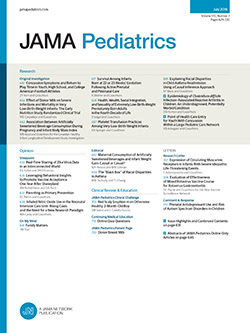Universal Free School Meal Policies and Participation in the US National School Meal Programs.
IF 18
1区 医学
Q1 PEDIATRICS
引用次数: 0
Abstract
Importance School meals can support children's health and educational outcomes; however, in the US, only students from households with incomes at or below 185% of the federal poverty level qualify for free or reduced-price meals. Although the Community Eligibility Provision (CEP) enables schools in higher poverty areas to offer free meals to all students, many schools do not participate; the temporary implementation of federal Universal Free School Meal (UFSM) policies during the COVID-19 pandemic and subsequent state-level policies highlight the need for assessing their impact on participation rates in school meal programs. Objective To examine the impact of federal- and state-level UFSM and related policies on National School Lunch Program (NSLP) and School Breakfast Program (SBP) participation rates during and after the COVID-19 pandemic. Design, Setting, and Participants This comparative effectiveness research study used a natural experiment created by the COVID-19 pandemic to analyze school-level data from the 2019 to 2020 school-year period to the 2023 to 2024 school-year period. A difference-in-difference analysis with linear mixed-effects models was conducted to assess the impact of federal-level UFSM implementation and deimplementation and state-level policies on SBP and NSLP participation rates. School-level meal claims data were analyzed across 14 states with UFSM or related policies and 11 comparison states, and schools participating in the NSLP and the SBP were included in this analysis. Exposures Federal UFSM policy, state-level UFSM policies, CEP participation, and limited expansions of free meal access. Main Outcomes and Measures Participation rates in SBP and NSLP, measured as percentage-point changes over time. Results Federal UFSM during the COVID-19 pandemic increased NSLP and SBP participation by 10 percentage points (range, -8 to 18 percentage points) and 8 percentage points (range, 2-20 percentage points), respectively, where percentage points refers to absolute changes in participation rates. Deimplementation in school year 2022 to 2023 reduced participation by 12 percentage points (range, -15 to -4 percentage points) for NSLP and 10 percentage points (range, -18 to -4 percentage points) for SBP. States that maintained UFSM policies showed consistently higher participation rates compared with states that discontinued UFSM, with increases between 9 and 19 percentage points (NSLP) and between 5 and 26 percentage points (SBP) in the first year of policy implementation, relative to the prior year. CEP participation resulted in substantial participation gains (23 percentage points for NSLP, 13 percentage points for SBP). State policies with limited free meal expansions showed no significant effect. Conclusions and Relevance Results of this comparative research analysis suggest that UFSM policies may effectively increase school meal participation, indicating the need for sustained state and federal support to increase participation rates and potentially mitigate diet-related disparities and food insecurity among children.普遍免费学校供餐政策和参与美国国家学校供餐计划。
学校膳食可以支持儿童的健康和教育成果;然而,在美国,只有家庭收入在联邦贫困线的185%或以下的学生才有资格享受免费或减价餐。虽然社区资格条款(CEP)使高贫困地区的学校能够为所有学生提供免费膳食,但许多学校并不参与;2019冠状病毒病大流行期间临时实施的联邦普遍免费学校供餐政策以及随后的州一级政策突出表明,有必要评估其对学校供餐计划参与率的影响。目的研究新冠肺炎疫情期间和疫情爆发后,联邦和州一级的全民健康管理及相关政策对全国学校午餐计划(NSLP)和学校早餐计划(SBP)参与率的影响。设计、环境和参与者本比较有效性研究使用COVID-19大流行创建的自然实验来分析2019 - 2020学年至2023 - 2024学年期间的校级数据。采用线性混合效应模型进行了差异分析,以评估联邦一级umfsm的实施和取消以及州一级政策对SBP和NSLP参与率的影响。学校膳食索赔数据在14个有umfsm或相关政策的州和11个比较州进行了分析,参与NSLP和SBP的学校也包括在这次分析中。暴露联邦统fsm政策,州一级的统fsm政策,CEP的参与,以及有限的扩展免费膳食访问。主要结果和测量方法SBP和NSLP的参与率,以随时间的百分点变化来衡量。结果2019冠状病毒病大流行期间,联邦统fsm将NSLP和SBP的参与率分别提高了10个百分点(范围,-8至18个百分点)和8个百分点(范围,2至20个百分点),其中百分比指参与率的绝对变化。在2022年至2023学年,NSLP的参与率下降了12个百分点(范围,-15至-4个百分点),SBP的参与率下降了10个百分点(范围,-18至-4个百分点)。与停止实施全民健康保险政策的州相比,维持全民健康保险政策的州的参与率始终较高,在政策实施的第一年,与前一年相比,参与率分别提高了9至19个百分点(NSLP)和5至26个百分点(SBP)。CEP的参与导致了实质性的参与率提高(NSLP为23个百分点,SBP为13个百分点)。有限制的免费膳食扩张的国家政策没有显着效果。本比较研究分析的结果表明,UFSM的政策可以有效地提高学校供餐的参与率,这表明需要州和联邦政府的持续支持,以提高参与率,并有可能减轻儿童饮食相关的差异和粮食不安全。
本文章由计算机程序翻译,如有差异,请以英文原文为准。
求助全文
约1分钟内获得全文
求助全文
来源期刊

JAMA Pediatrics
PEDIATRICS-
CiteScore
31.60
自引率
1.90%
发文量
357
期刊介绍:
JAMA Pediatrics, the oldest continuously published pediatric journal in the US since 1911, is an international peer-reviewed publication and a part of the JAMA Network. Published weekly online and in 12 issues annually, it garners over 8.4 million article views and downloads yearly. All research articles become freely accessible online after 12 months without any author fees, and through the WHO's HINARI program, the online version is accessible to institutions in developing countries.
With a focus on advancing the health of infants, children, and adolescents, JAMA Pediatrics serves as a platform for discussing crucial issues and policies in child and adolescent health care. Leveraging the latest technology, it ensures timely access to information for its readers worldwide.
 求助内容:
求助内容: 应助结果提醒方式:
应助结果提醒方式:


